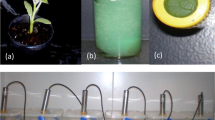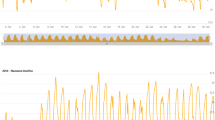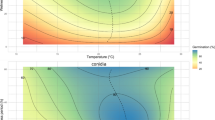Abstract
Trichothecium roseum is an important pathogen and causes moldy core and black spots on apple fruit. The effects of temperature, moisture and nutrition on conidial germination, survival, colonization and sporulation of T. roseum were examined in controlled environments. The results revealed that external nutriments, such as extracts from apple fruit and flower promoted the conidial germination. The temperature required for conidial germination and sporulation of T. roseum ranged from 10 °C to 35 °C, with an optimum at approximately 28 °C. No conidia were produced at 35 °C, although conidia germinated at this temperature. The lethal temperature for the conidia was 46 °C and the conidia survived for 6.8 days at 40 °C. The most favorable moisture for conidial germination and sporulation of the pathogen was 95% relative humidity (RH). The humidity limit was RH = 90% for the conidial germination and RH = 70% for the fungal sporulation. At the optimum temperature, the fungi finished one generation (i.e., from conidial germination to sporulation) was no more than two days in Malus micromalus flowers, although the conidia germinated more slowly in vitro. Conidial germination and sporulation dynamics of T. roseum were well described by modified logistic models. The results can be used to develop disease forecasting model and help improving fungicide control of the disease.









Similar content being viewed by others
References
Arauz, L. F., Neufeld, K. N., Lloyd, A. L., & Ojiambo, P. S. (2010). Quantitative models for germination and infection of Pseudoperonospora cubensis in response to temperature and duration of leaf wetness. Phytopathology, 100(9), 959–967.
Bello, D. (2008). First report of Trichothecium roseum causing postharvest fruit rot of tomato in Argentina. Australasian Plant Disease Notes, 3(1), 103–104.
Chen, Y., Wen, J., & Lijun, L. I. (2006). Research advance of grape grey mould. Journal of Northeast Agricultural University, 37(5), 693–699.
Duthie, J. (1997). Models of the response of foliar parasites to the combined effects of temperature and duration of wetness. Phytopathology, 87(11), 1088–1095.
Elad, Y., Yunis, H., & Volpin, H. (1993). Effect of nutrition on susceptibility of cucumber, eggplant, and pepper crops to Botrytis cinerea. Botany, 71(4), 602–608.
Ellis, M. A. (1980). Fungi associated with moldy-core of apple and their location within fruit. Research circular. Ohio Agricultural Research and Development Center, 259, 36–38.
Gao, L. L., Zhang, Q., Sun, X. Y., Jiang, L., Zhang, R., Sun, G. Y., Zha, Y. L., & Biggs, A. R. (2013). Etiology of moldy Core, Core Browning, and Core rot of Fuji apple in China. Plant Disease, 97(4), 510–516.
Guo, Y. Z., Sun, G. Y., Gao, B. W., Chun-You, L. I., Zhang, P. L., & Lei, X. L. (2005). Studies on the identification of pathogen and the biological characteristics of black-dot disease of bagged apple. Acta Agriculturae Boreali-occidentalis Sinica, 14(3), 18–21.
Hamid, M. I., Hussain, M., Ghazanfar, M. U., Raza, M., & Liu, X. Z. (2014). Trichothecium roseum causes fruit rot of tomato, orange, and apple in Pakistan. Plant Disease, 98(9), 1271–1271.
Hao, X. A., Yun feng, W. U., Zhou, X. M., & Yang, Y. (2004). Preliminary studies on the identification and occurrence of black-dot disease on bagged apple fruit in Shaanxi. Acta Agriculturae Boreali-Occidentalis Sinica, 13(4), 54–57.
Hao, B. F., Yu, L. C., Xu, C. X., He, L. M., & Jiao, R. (2010). Tarsonemus confusus causes black-dot disease of bagged fruits on apple trees and its control. Journal of Fruit Science, 27(6), 956–960.
Harris, R. F., Gardner, W. R., Adebayo, A. A., & Sommers, L. E. (1970). Agar dish isopiestic equilibration method for controlling the water potential of solid substrates. Applied and Environmental Microbiology, 19(3), 536–537.
Hasija, S. K., & Agarwal, H. C. (1978). Nutritional physiology of Trichothecium roseum. Mycologia, 70(1), 47–60.
Hu, L., Ma, C., Zhang, J., Tan, W., Yang, G., & Zhang, L. (1995). Infection process of pathogenic fungi contributing to mouldy core and core rot of starking apples fruits. Acta Phytopathologica Sinica, 25(04), 351–356.
Hu, L., Ma, C., Yang, G., & Tang, W. (1996). Study on causal agent of apple mouldy core and core rot (in Chinese). Journal of Fruit Science, 1996(03), 157–161.
Karabulut, O. A., Romanazzi, G., Smilanick, J. L., & Lichter, A. (2005). Postharvest ethanol and potassium sorbate treatments of table grapes to control gray mold. Postharvest Biology and Technology, 37(2), 129–134.
Lang, A. (1967). Osmotic coefficients and water potentials of sodium chloride solutions from 0 to 40°C. Australian Journal of Chemistry, 20(9), 2017–2023.
Li, B., Zhao, H., Li, B., & Xu, X. M. (2003). Effects of temperature, relative humidity and duration of wetness period on germination and infection by conidia of the pear scab pathogen (Venturia nashicola). Plant Pathology, 52(5), 546–552.
Li, E. M., Shi, D. C., Xu, Y. H., Chen, F., & Zhai, H. (2008). Changing characteristics of temperature and humidity in different type bags for bagging apple and their effects on fruit appearance quality. Chinese Journal of Applied Ecology, 19(1), 208–212.
Li, X., JIn, J., Li, B., Wang, C., Dong, X., & Wang, C. (2016). Community structure and temporal dynamics of fungi in cuticle and core of bagging and un-bagging apple fruit. Mycosystema, 35(8), 927–938.
Lin, S. H., Wang, J., & Wu, A. B. (2016). A post-harvest pink rot of pepper caused by Trichothecium roseum in China. Plant Disease, 100(10), 2164–2164.
Liu, Y. L., Fan, C. H., Che, F., Hui, M. A., Zhao, Z. Y., & Jiang, H. X. (2007). Occurrencs of black-dot disease on bagged apple in Shaanxi Province. Journal of Northwest Forestry University, 2007(03), 116–119.
May-De-Mio, L. L., Negri, G., & Michailides, T. J. (2014). Effect of Trichothecium roseum, lime Sulphur and phosphites to control blossom blight and brown rot on peach. Canadian Journal of Plant Pathology-Revue Canadienne De Phytopathologie, 36(4), 428–437.
Moreira, L. M., & May-De-Mio, L. L. (2007). Mycelial growth of monilinia fructicola and trichothecium roseum in several temperatures and sensitivity of antagonist to fungicides and phosphites. Scientia Agraria Curitiba, 2007(3), 337–341.
Ntasiou, P., Myresiotis, C., Konstantinou, S., Papadopoulou-Mourkidou, E., & Karaoglanidis G. S. (2015). Identification, characterization and mycotoxigenic ability of Alternaria spp. causing core rot of apple fruit in Greece. International Journal of Food Microbiology, 197:22–9.
Oh, S., Nam, K., & Yoon, D. (2014). Identification of Acremonium acutatum and Trichothecium roseum isolated from grape with white stain symptom in Korea. Mycobiology, 42(3), 269–273.
Shtienberg, D. (2012). Effects of host physiology on the development of core rot, caused by alternaria alternata, in red delicious apples. Phytopathology, 102(8), 769–778.
Silveira, F. N., Kretzschmar, A. A., Rufato, L., Bogo, A., & Fioravanço, J. C. (2013). Relationship between fruit morphological characteristics and incidence of moldy core in 'Gala' and 'Fuji' apple clones on different rootstocks. Revista Brasileira de Fruticultura 35(1), 75–85.
Sun, S., Lian, S., Feng, S., et al. (2016). Effects of temperature and moisture on sporulation and infection by Pseudoperonospora cubensis. Plant Disease, 101(4), 562–567.
Tang, Z., Chen, C., Hui, W., Shi, X., & Chen, Y. (2003). Studies on the occurrence of black-dot disease of bagged apple. Journal of Northwest Sci-Tech University of Agriculture and Forestry, 2003(02), 59–61.
Vercesi, A., Locci, R., & Prosser, J. I. (1997). Growth kinetics of Botrytis cinerea on organic acids and sugars in relation to colonization of grape berries. Fungal Biology, 101(2), 139–142.
Wang, C., Jin, J., Li, B., Wang, C., Dong, X., & Zhang, Z. (2014). Pathogens isolated from different symptoms of black spot disease and infection conditions. Acta Agriculturae Boreali-Occidentalis Sinica, 29(6), 136–144.
Wang, B., Li, B., Dong, X., Wang, C., & Zhang, Z. (2015). Effects of temperature, wetness euration, and moisture on the conidial germination, infection, and disease incubation period of Glomerella cingulata. Plant Disease, 99(2), 249–256.
Xin, Y., Qin, S., Li, B., Yin, S., Ding, X., & Lei, C. (2000). Control efficacy and inhibitory action of Bacillus subtilis XM16 strain on disease and pathogens of apple mould core. Acta Phytopathologica Sinica, 30(01), 66–70.
Zeng, M., Wang, H., & Wang j, H. L. (2014). Influence of bagging Fuji fruit on the rate the of calyx tube opened and moldy core disease. Northern Horticulture, 2014(15), 122–124.
Zhang, Z. M., & Yang, B. I. (2006). Research on biological characteristics of Trichothecium roseum. Journal of Gansu Agricultural University, 41(4), 86–90.
Acknowledgements
This research was funded by National Key Research and Development Program of China (2016YFD0201122), Agricultural Science and Technology Innovation Project of Shandong Academy of Agricultural Sciences (2017CXGC0214), China Agriculture Research System (CARS-27), and Taishan Scholar Construction Project of Shandong Province.
Author information
Authors and Affiliations
Corresponding author
Ethics declarations
Conflict of interest
The authors declare that they have no conflicts of interest.
Human and animal rights
This research does not include any animal and/or human trials.
Rights and permissions
About this article
Cite this article
Li, X., Li, Bh., Lian, S. et al. Effects of temperature, moisture and nutrition on conidial germination, survival, colonization and sporulation of Trichothecium roseum. Eur J Plant Pathol 153, 557–570 (2019). https://doi.org/10.1007/s10658-018-1583-8
Accepted:
Published:
Issue Date:
DOI: https://doi.org/10.1007/s10658-018-1583-8




